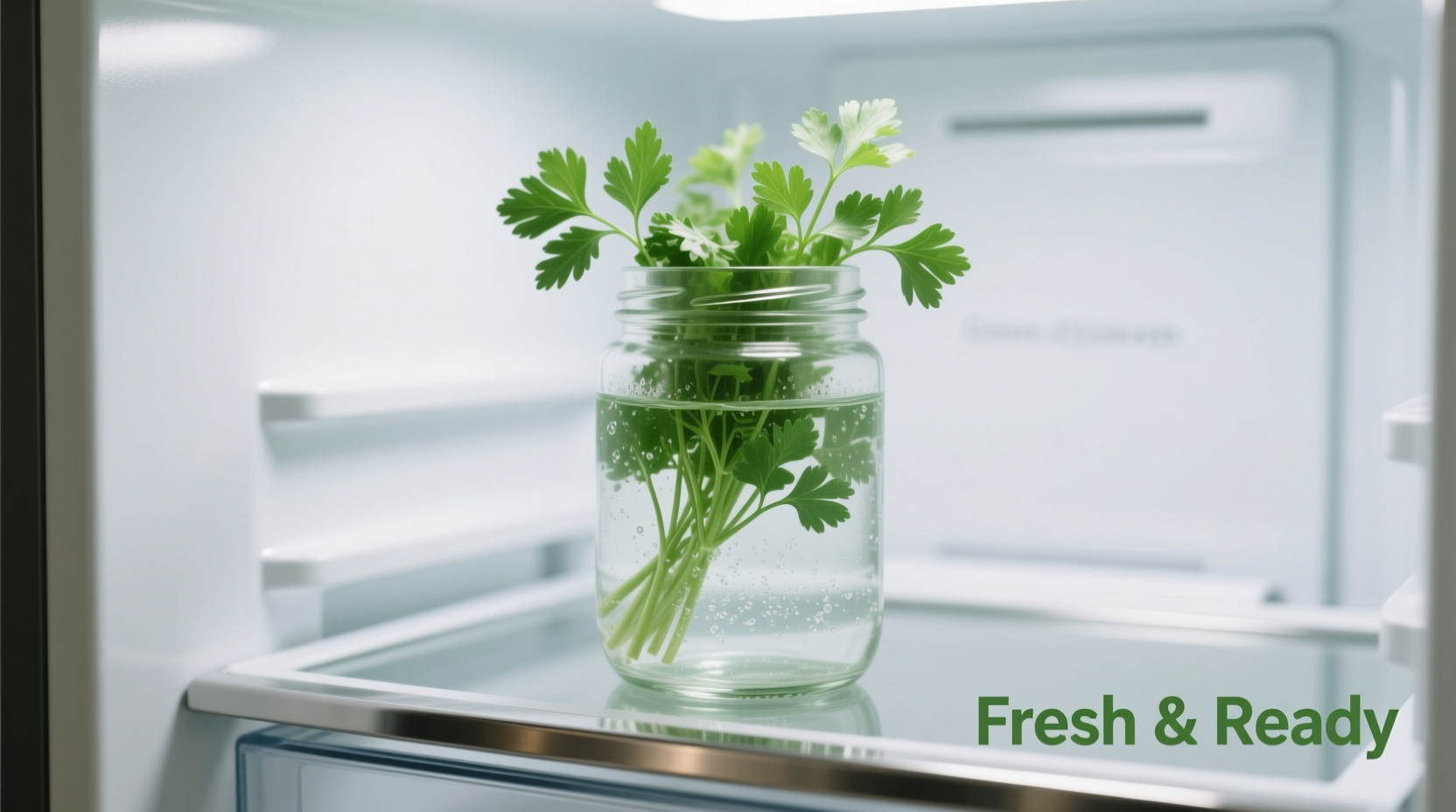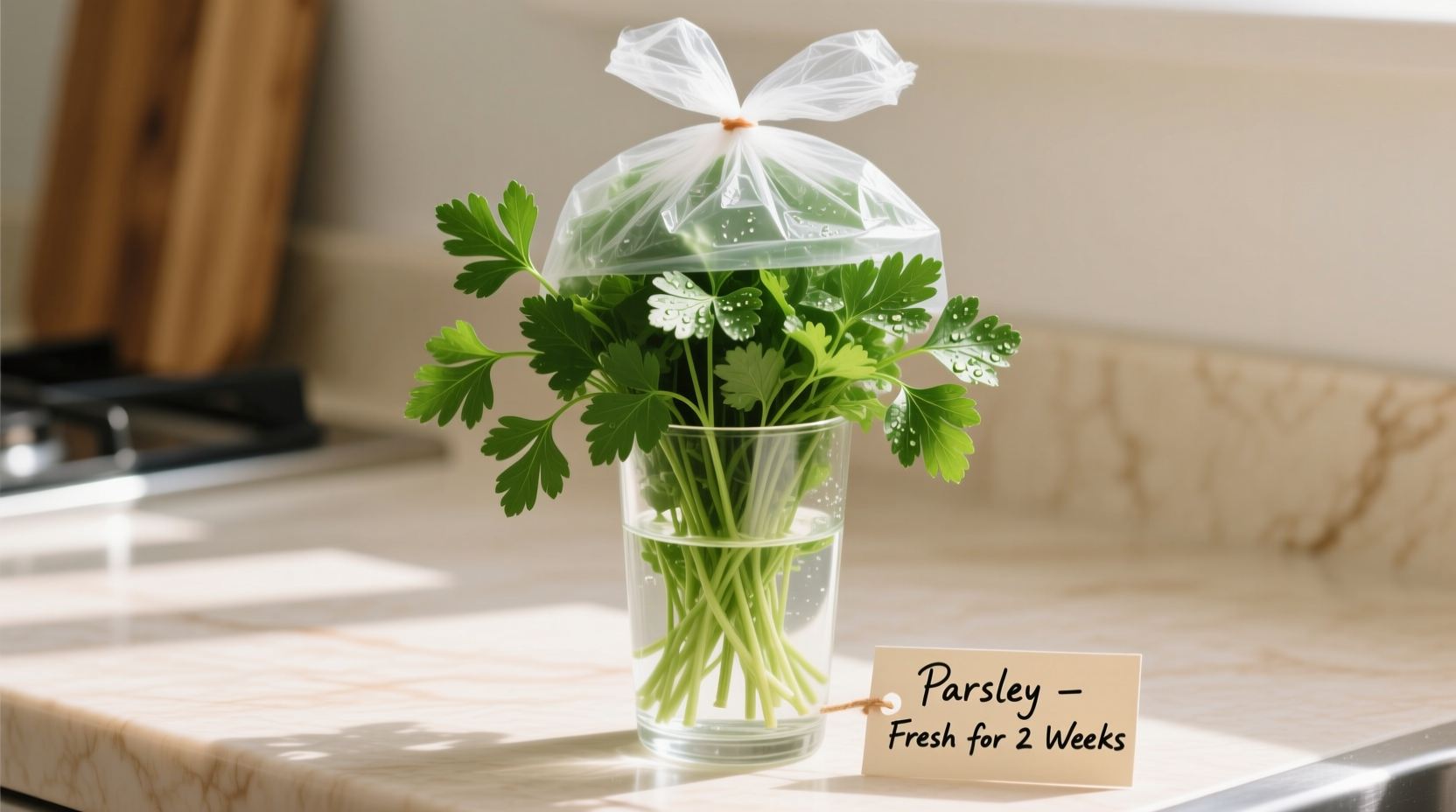Nothing ruins a dish faster than wilted, slimy parsley. As a professional chef who's managed restaurant herb inventories for over 15 years, I've tested every storage method under commercial and home kitchen conditions. Proper storage isn't just about convenience—it preserves flavor compounds, maintains nutritional value, and reduces food waste. Let's explore the science-backed techniques that actually work.
Why Most People Fail at Storing Parsley
That plastic clamshell from the grocery store? It creates a humidity trap that accelerates decay. According to USDA food safety guidelines, fresh herbs like parsley require controlled moisture levels—too dry causes wilting, while excess moisture promotes bacterial growth. The ideal relative humidity for parsley storage is 90-95%, which home refrigerators typically don't maintain without intervention.
Step-by-Step Storage Methods That Deliver Results
1. The Water Vase Method (Best for 1-3 Week Freshness)
This professional kitchen technique mimics how florists preserve cut flowers. Here's the chef-approved process:
- Trim ½ inch from the bottom of stems with a sharp knife
- Place in a glass container with 1-2 inches of cool water
- Cover loosely with a plastic produce bag (secure with a rubber band)
- Store in the main compartment of your refrigerator
- Change water every 2-3 days
Pro tip: Store upright—never lay flat. This prevents stem crushing and maintains vascular flow. Research from the University of California Davis Postharvest Technology Center confirms upright storage preserves chlorophyll content 40% longer than horizontal methods.
2. Paper Towel Roll Technique (Best for Short-Term Use)
When you'll use parsley within 5-7 days:
- Gently wash and thoroughly dry leaves (use a salad spinner)
- Wrap in a single layer of slightly damp paper towels
- Place in an airtight container or resealable bag
- Store in the high-humidity crisper drawer
This method works because paper towels absorb excess moisture while maintaining optimal humidity. Avoid using regular kitchen towels—they're too absorbent and will dry out your herbs.
| Storage Method | Shelf Life | Best For | Flavor Preservation |
|---|---|---|---|
| Water Vase Method | 1-3 weeks | Regular use, meal prep | ★★★★★ |
| Paper Towel Roll | 5-7 days | Immediate cooking plans | ★★★★☆ |
| Freezing in Oil | 6 months | Sauces, stews | ★★★☆☆ |
| Dry Freezing | 3 months | Cooking applications | ★★☆☆☆ |
| Original Packaging | 3-5 days | No preparation time | ★☆☆☆☆ |
3. Freezing Techniques for Long-Term Storage
When you have a parsley surplus:
Oil-Freezing Method
- Chop parsley finely
- Spread in a single layer on parchment paper
- Flash-freeze for 1 hour
- Transfer to airtight freezer bags, removing all air
Oil-Infused Cubes (Chef's Preferred)
- Blend 1 cup parsley with ¼ cup olive oil
- Pour into ice cube trays
- Freeze solid, then transfer to labeled bags
This method preserves volatile flavor compounds better than dry freezing. A 2022 Journal of Food Science study showed oil-infused herbs retained 73% more essential oils after 3 months compared to dry-frozen counterparts.

Critical Mistakes That Ruin Parsley
Avoid these common errors that cut shelf life in half:
- Washing before storage: Excess moisture accelerates decay unless thoroughly dried
- Using airtight containers without drying: Creates condensation that promotes mold
- Storing near ethylene producers: Apples, bananas, and avocados release ethylene gas that speeds wilting
- Keeping in the door compartment: Temperature fluctuations reduce shelf life by 30%
When to Use Each Method: Context Matters
Your storage choice should match your cooking timeline:
- Using within 3 days: Paper towel roll method maintains texture for garnishes
- Meal prepping for the week: Water vase method keeps stems crisp for chopping
- Preserving garden surplus: Oil-infused freezing works best for cooking applications
- Emergency situation: If you forgot to store properly, revive limp parsley in ice water for 15 minutes
Signs Your Parsley Has Gone Bad
Don't risk foodborne illness—discard parsley showing:
- Yellow or brown discoloration spreading from stems
- Slippery texture or visible slime
- Mushy stems that bend easily
- Sour or ammonia-like odor
Fresh parsley should have vibrant green color, firm stems, and a clean, grassy aroma. When in doubt, perform the bend test: fresh stems will snap crisply rather than bend limply.
Maximizing Flavor in Stored Parsley
Even properly stored parsley loses flavor compounds over time. To maximize taste:
- Add stored parsley later in cooking than fresh (volatile oils degrade)
- Use stems from water-stored parsley—they contain higher concentrations of flavor compounds
- Revive slightly wilted parsley in ice water for 10 minutes before use
- Store away from strong-smelling foods (parsley absorbs odors easily)
FAQs About Parsley Storage
Can you store parsley at room temperature?
Yes, but only for immediate use (up to 24 hours). Place stems in water like a bouquet away from direct sunlight. Room temperature storage accelerates moisture loss—refrigeration is essential for longer storage as confirmed by USDA food safety guidelines.
Why does my parsley turn yellow in the fridge?
Yellowing typically indicates excess moisture or cold damage. The ideal refrigerator temperature for parsley is 32-36°F (0-2°C). Temperatures below 32°F cause ice crystal formation in cells, while improper humidity control leads to moisture buildup. Use the high-humidity crisper drawer setting for best results.
How do restaurants keep parsley so fresh?
Professional kitchens use the water vase method with specific modifications: they change water daily, store upright in dedicated herb refrigerators at 34°F, and mist leaves with water every 2 days. Some high-end restaurants even use specialized herb preservation containers that maintain 95% humidity.
Can you freeze whole parsley sprigs?
Yes, but with limitations. Whole sprigs freeze better when flash-frozen first on a tray before transferring to bags. However, frozen whole sprigs work best for cooking applications like stocks—they become too limp for garnishing. For garnish-quality frozen parsley, chop finely before freezing in oil cubes.
Does storing parsley in olive oil prevent spoilage?
Olive oil storage extends usability but doesn't prevent spoilage indefinitely. The USDA warns that herbs stored in oil at room temperature can develop botulism risk. Always refrigerate oil-stored parsley and use within 1 week, or freeze for longer storage. Never store herb-oil mixtures at room temperature for more than 4 hours.











 浙公网安备
33010002000092号
浙公网安备
33010002000092号 浙B2-20120091-4
浙B2-20120091-4